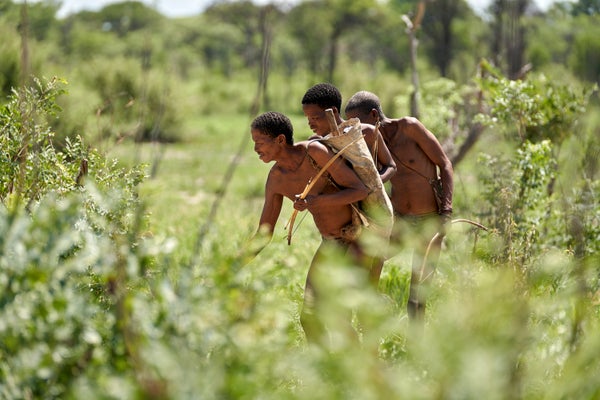Anyone lucky enough to have visited the Okavango Delta in the southern African nation of Botswana will recall the comforting and oddly familiar sensation of looking out from the shelter of a stand of trees at the panorama of wildlife—from elephants and African wild dogs to lilac-breasted rollers—moving across the lush surrounding floodplains. That sense of familiarity may run deeper than we imagine, a new study suggests—back to a time when early modern humans also wandered there.
The study, appearing Monday in the journal Nature, uses genetic, archaeological, linguistic and climatic evidence to argue that the ancestral homeland of everyone alive today was in northern Botswana—not in East Africa, as previously thought.Based on mitochondrial DNA, passed down from mother to daughter, the paper’s co-authors argue that we are all descended from a small community of Khoisan hunter-gatherers who lived 200,000 years ago in vast wetlands encompassing Botswana’s Okavango Delta and the Makgadikgadi regions.
Much of that place is now a dry salt pan—and inhabited by modern Khoisan people, sometimes called Bushmen. But back then, it was a vast wetland covering an area the size of Switzerland. The community that lived there was unusually stable, thriving almost unchanged for 70,000 years in a habitat closely resembling the modern Okavango Delta, according to senior author Vanessa M. Hayes,a geneticist at the Garvan Institute of Medical Research in Australia.
On supporting science journalism
If you're enjoying this article, consider supporting our award-winning journalism by subscribing. By purchasing a subscription you are helping to ensure the future of impactful stories about the discoveries and ideas shaping our world today.
The new study looks at the mitogenomes, or mitochondrial genomes, of 1,217 individuals from multiple southern African ethnic identities, and focuses on a “rare deep-rooting” lineage called L0, or L zero.It’s the oldest known mitochondrial lineage, passed down intact from mother to daughter across the generations, though mutations can sometimes occur and may be associated with important evolutionary changes. Hayes became interested in that lineage as a result of her work with the South African Genome Project, which found evidence of L0 ancestry distributed across southern Africa. Archbishop Emeritus Desmond Tutu, descended mainly from Bantu groups who migrated into southern Africa 1,500 years ago, was among those identified as having Khoisan ancestry, a connection he said left him feeling “very privileged and blessed."
Tracking the accumulation of mutations in the L0 lineage across the eons provides geneticists with a time stamp for evolutionary changes. The co-authors of the Nature paper identify and date changes in the L0 lineage. They also correlate these “branching” events with evidence of climatic shifts, as well as with archaeological evidence of human migrations. During the initial 70,000 years of stable habitation, says co-author Axel Timmermann, a climate scientist at Pusan National University in South Korea, migration was probably constrained by harsh, dry conditions in the surrounding landscape. But about 130,000 years ago, a period of increased rainfall opened a green corridor for migrations to the northeast. Then, about 110,000 years ago, drying conditions within the homeland and opening of a green corridor to the southwest led to further migrations down to the southern tip of Africa. Evidence of both events survives, according to the study, in subgroups of the L0 lineage found in living descendants of those migrations.
The new research fits with other recent genetic evidence of human origin in southern Africa, including a study earlier this year suggesting that a migration from that region to East Africa, and the resulting mixture with populations there, might have been a key turning point in the evolution of modern humans and their migration out of Africa. Another paper this year also argues that a migration from southern Africa to East Africa immediately preceded a major out-of-Africa migration 100,000 to 70,000 years ago. The alternative pan-African, or “polycentric,” viewpoint holds that multiple interlinked populations evolved across the continent, sometimes in isolation and sometimes together.
James Cole, an archaeologist at the University of Brighton in England, who was not involved in the new study, praises Hayes and her colleagues for their cross-disciplinary approach to understanding mitochondrial evolution. But he also notes that their paper overlooks major archaeological evidence, such as the 315,000-year-old skeletal remains of an anatomically modern human recently found in Morocco. Hayes replies that her study focuses only on the population of direct ancestors of “people walking around today,” and in the absence of genetic evidence from the Morocco specimens, the connection to living humans is unknown.
Milford Wolpoff, a paleoanthropologist at the University of Michigan who also was not involved in the new work, similarly argues that the evidence its authors present is too narrow. Reliance solely on mitochondrial evidence leads to misinterpretation, he says, and risks overlooking important evolutionary information in the separate DNA of the cell nucleus. Our widespread inheritance of Neandertal genes shows up, for instance, only in the nuclear DNA, and it is completely absent from the mitogenome. Likewise, Wolpoff says, “the nuclear genome, with three billion base pairs, might tell an entirely different story about the African origin of modern humans from what the mitogenome’s 16,000 base pairs” suggest.
“We’re dealing with a puzzle of a million pieces,” Cole says, “and we’ve probably got the first 100 in place.” Paleogenetics has “ramped up the scale of complexity exponentially,” he adds. “From the paleontological and archeological record, it was a 1,000-piece puzzle.” But instead of providing a grand answer to the story of human origin, Cole suggests, so far, genetics is mainly showing us just how complex that story really is.
